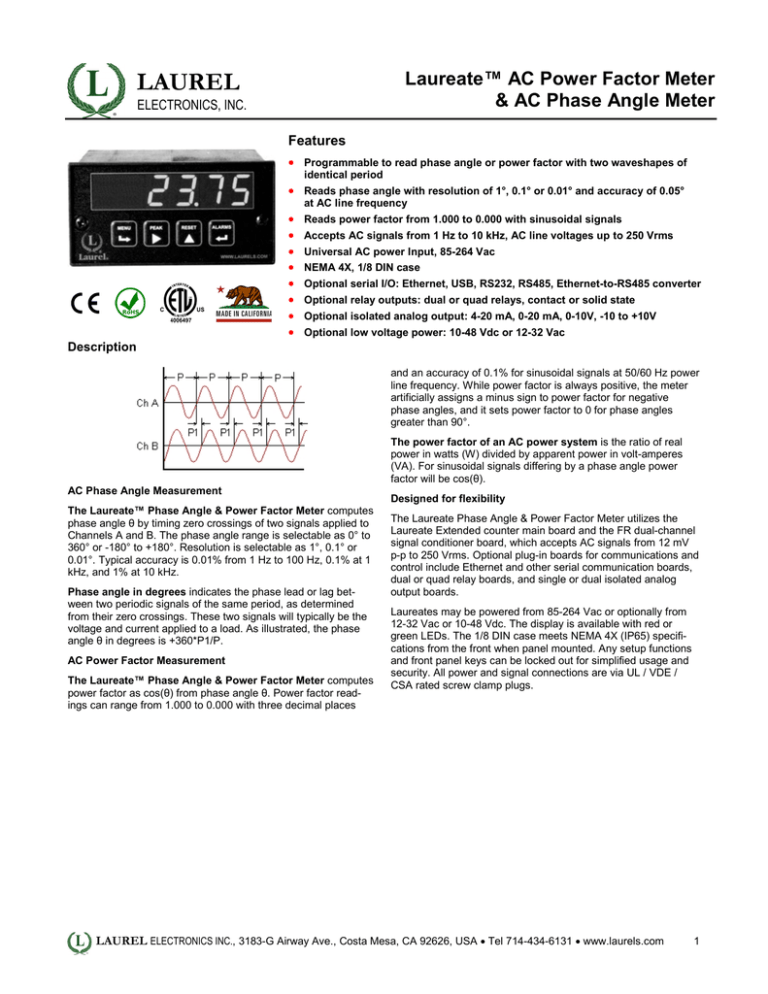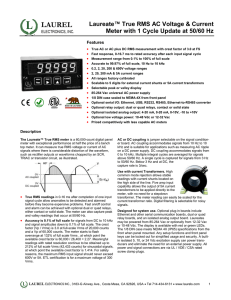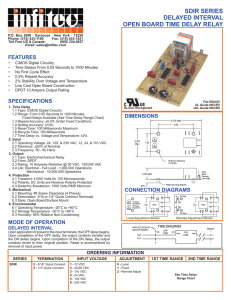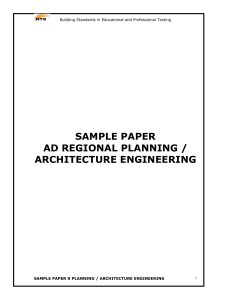Datasheet - Laurel Electronics
advertisement

Laureate™ AC Power Factor Meter & AC Phase Angle Meter LAUREL ELECTRONICS, INC. Features • Programmable to read phase angle or power factor with two waveshapes of identical period • Reads phase angle with resolution of 1°, 0.1° or 0.01° and accuracy of 0.05° at AC line frequency • • • • • • • • Reads power factor from 1.000 to 0.000 with sinusoidal signals Accepts AC signals from 1 Hz to 10 kHz, AC line voltages up to 250 Vrms Universal AC power Input, 85-264 Vac NEMA 4X, 1/8 DIN case Optional serial I/O: Ethernet, USB, RS232, RS485, Ethernet-to-RS485 converter Optional relay outputs: dual or quad relays, contact or solid state Optional isolated analog output: 4-20 mA, 0-20 mA, 0-10V, -10 to +10V Optional low voltage power: 10-48 Vdc or 12-32 Vac Description and an accuracy of 0.1% for sinusoidal signals at 50/60 Hz power line frequency. While power factor is always positive, the meter artificially assigns a minus sign to power factor for negative phase angles, and it sets power factor to 0 for phase angles greater than 90°. The power factor of an AC power system is the ratio of real power in watts (W) divided by apparent power in volt-amperes (VA). For sinusoidal signals differing by a phase angle power factor will be cos(θ). AC Phase Angle Measurement The Laureate™ Phase Angle & Power Factor Meter computes phase angle θ by timing zero crossings of two signals applied to Channels A and B. The phase angle range is selectable as 0° to 360° or -180° to +180°. Resolution is selectable as 1°, 0.1° or 0.01°. Typical accuracy is 0.01% from 1 Hz to 100 Hz, 0.1% at 1 kHz, and 1% at 10 kHz. Phase angle in degrees indicates the phase lead or lag between two periodic signals of the same period, as determined from their zero crossings. These two signals will typically be the voltage and current applied to a load. As illustrated, the phase angle θ in degrees is +360*P1/P. AC Power Factor Measurement The Laureate™ Phase Angle & Power Factor Meter computes power factor as cos(θ) from phase angle θ. Power factor readings can range from 1.000 to 0.000 with three decimal places Designed for flexibility The Laureate Phase Angle & Power Factor Meter utilizes the Laureate Extended counter main board and the FR dual-channel signal conditioner board, which accepts AC signals from 12 mV p-p to 250 Vrms. Optional plug-in boards for communications and control include Ethernet and other serial communication boards, dual or quad relay boards, and single or dual isolated analog output boards. Laureates may be powered from 85-264 Vac or optionally from 12-32 Vac or 10-48 Vdc. The display is available with red or green LEDs. The 1/8 DIN case meets NEMA 4X (IP65) specifications from the front when panel mounted. Any setup functions and front panel keys can be locked out for simplified usage and security. All power and signal connections are via UL / VDE / CSA rated screw clamp plugs. LAUREL ELECTRONICS INC., 3183-G Airway Ave., Costa Mesa, CA 92626, USA • Tel 714-434-6131 • www.laurels.com 1 Specifications Phase Angle Mode Item Displayed Display Units Frequency Range Resolution Accuracy Maximum Timing Interval Phase angle difference between two waves of same period 1°, 0.1°, 0.01° 0.005 Hz to 10 kHz 0.01°, 1 Hz to 100 Hz; 0.1° at 1 kHz; 1° at 10 kHz 0.03° at 50 or 60 Hz 200 sec Power Factor Mode Item Displayed Display Units Polarity Frequency Range Accuracy Power factor between two sine waves of same period 1.000 to 0.000, 1.00 to 0.00, or 1.0 to 1.0 Negative sign indicates negative phase angle 0.005 Hz to 10 kHz 0.1% at power line frequencies Update Rate Timing interval Gate Time Time Before Zero Out Gate time + 30 ms+ 0-2 signal periods Selectable 10 ms to 199.99 s Selectable 10 ms to 199.99 s (to indicate loss of signal) Display Readout Range Indicators 6 LED digits, 7-segment, 14.2 mm (.56"), red or green -999999 to +999999 Four LED lamps Inputs Signal ranges Signal ground Noise filter Nine AC signal ranges from 12 mVp-p to 250 Vac Common ground for channels A & B 1 MHz, 30 kHz, 250 Hz (jumper selectable) + digital filter Power Voltage, standard Voltage, optional Power frequency Power consumption (typical, base meter) Power isolation 85-264 Vac or 90-300 Vdc 12-32 Vac or 10-48 Vdc DC or 47-63 Hz 1.2W @ 120 Vac, 1.5W @ 240 Vac, 1.3W @ 10 Vdc, 1.4W @ 20 Vdc, 1.55W @ 30 Vdc, 1.8W @ 40 Vdc, 2.15W @ 48 Vdc 250V rms working, 2.3 kV rms per 1 min test Excitation Output (standard) 5 Vdc 10 Vdc 24 Vdc Output Isolation 5 Vdc ± 5%, 100 mA 10 Vdc ± 5%, 120 mA 24 Vdc ±5 %, 50 mA 50 Vdc to meter ground Analog Output (optional) Output Levels Current compliance Voltage compliance Scaling Resolution Isolation 4-20 mA, 0-20 mA, 0-10V, -10 to +10V (jumper selectable) 2 mA at 10V ( > 5 kΩ load) 12V at 20 mA ( < 600Ω load) Zero and full scale adjustable from -99999 to +99999 16 bits (0.0015% of full scale) 250V rms working, 2.3 kV rms per 1 min test Relay Outputs (optional) Relay Types Current Ratings Output common Isolation 2 Form C contact relays or 4 Form A contact relays (NO) 2 or 4 Form A, AC/DC solid state relays (NO) 8A at 250 Vac or 24 Vdc for contact relays 120 mA at 140 Vac or 180 Vdc for solid state relays Isolated commons for dual relays or each pair of quad relays 250V rms working, 2.3 kV rms per 1 min test LAUREL ELECTRONICS INC., 3183-G Airway Ave., Costa Mesa, CA 92626, USA • Tel 714-434-6131 • www.laurels.com 2 Serial Data I/O (optional) Board Selections Protocols Data Rates Digital Addresses Isolation Ethernet, Ethernet-to-RS485 server, USB, USB-to-RS485 server, RS485 (dual RJ11), RS485 Modbus (dual RJ45), RS232. Modbus RTU, Modbus ASCII, Laurel ASCII protocol 300 to 19200 baud 247 (Modbus), 31 (Laurel ASCII), 250V rms working, 2.3 kV rms per 1 min test Environmental Operating Temperature Storage Temperature Relative Humidity Protection 0°C to 55°C -40°C to 85°C 95% at 40°C, non-condensing NEMA-4X (IP-65) when panel mounted Signal Connections Mechanical LAUREL ELECTRONICS INC., 3183-G Airway Ave., Costa Mesa, CA 92626, USA • Tel 714-434-6131 • www.laurels.com 3 Application Examples Optimizing Meter Inputs for Phase Angle & Power Factor Measurement Phase angle and power factor measurement with the Laureate™ Phase Angle & Power Factor Meter require that two signals of identical periods be applied to Channels A and B. For best accuracy, both signals should have the same amplitude, the signal amplitude should be larger than 1V, and the trigger level should be minimized by selecting the ±12 mV jumper position. The meter times zero crossings to 0.1 µs resolution over a user-selectable gate time from 10 ms to 199.99 s. By selecting the minimum gate time of 10 ms, the meter update rate will be approximately 20/s for 50/60 Hz AC line frequency. Improved accuracy will be obtained by making the gate time long enough so that multiple cycles are averaged. Both signals applied to the meter should be mutually isolated by transformer coupling, so that they can then share the same ground in the meter. The current signal is typically obtained from a current transformer (CT). This should ideally be a CT with a voltage output or a current output in the mA range, which can then be converted to a voltage higher than 1V across an external dropping resistor without excessive heat generation. Using Laureate Meters and Counters to Synchronize Motor Generators Synchronization of two motor generators requires that the two frequencies be identical, that the lines be in phase, and that the line voltages be close to each other. In this illustration, a single Laureate dual channel counter measures both frequencies to six-figure accuracy in a few line cycles. Another Laureate dual channel counter measures phase angle to 0.1° resolution. Two Laureate AC RMS Voltmeters, which offer ranges of 200.00 V and 600.0 V, are used to display the two RMS voltages to 0.1% accuracy LAUREL ELECTRONICS INC., 3183-G Airway Ave., Costa Mesa, CA 92626, USA • Tel 714-434-6131 • www.laurels.com 4 Ordering Guide Create a model number in this format: L70000FR, IPC Main Board L7 Extended Main Board, Green LEDs L8 Extended Main Board, Red LEDs Note 1: Use of the Extended Main Board also makes this counter suitable for A-B time interval, stopwatch, frequency, rate, period, square root of rate, up or down total, arithmetic functions, simultaneous rate and total, duty cycle, batching, and custom curve linearization. Note 2: If the meter is to be used for power factor, please so indicate in a note at the time order. Power 0 Isolated 85-264 Vac 1 Isolated 12-32 Vac or 10-48 Vdc Relay Output (isolated) 0 1 2 3 4 Analog Output (isolated) 0 None 1 Single isolated 4-20 mA, 0-20 mA, 0-10 V, -10 to +10V 2 Dual isolated 4-20 mA, 0-20 mA, 0-10V Digital Interface (isolated) 0 1 2 4 5 6 7 8 Input Type FR Dual-Channel Pulse Input Signal Conditioner Add-on Options CBL01 None Two 8A Contact Relays Two 120 mA Solid State Relays Four 8A Contact Relays Four 120 mA Solid State Relays None RS-232 RS485 (dual RJ11 connectors) RS485 Modbus (dual RJ45 connectors) USB USB-to-RS485 converter Ethernet Ethernet-to-RS485 converter RJ11-to-DB9 cable. RJ11 to DB9. Connects RS232 ports of meter and PC. USB-to-DB9 adapter cable. Combination of CBL02 and CBL01 connects meter RS232 port to PC USB port. CBL03-1 6-wire data cable, RJ11 to RJ11, 1 ft. Used to daisy chain meters via RS485. CBL02 CBL03-7 6-wire data cable, RJ11 to RJ11, 7 ft. Used to daisy chain meters via RS485. CBL05 USB cable, A-B. Connects USB ports of meter and PC. CBL06 USB to RS485 adapter cable, half duplex, RJ11 to USB. Connects meter RS485 port to PC USB port. CASE1 Benchtop laboratory case for one 1/8 DIN meter CASE2 Benchtop laboratory case for two 1/8 DIN meters IPC BOX1 BOX2 BL Splash-proof cover NEMA-4 Enclosure NEMA-4 enclosure plus IPC Blank Lens without button pads NL Meter lens without button pads or Laurel logo LAUREL ELECTRONICS INC., 3183-G Airway Ave., Costa Mesa, CA 92626, USA • Tel 714-434-6131 • www.laurels.com 5




